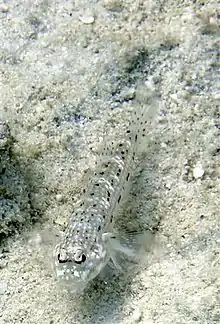Fusigobius
Fusigobius is a genus of coral reef inhabiting gobies found throughout the Indian and western Pacific Oceans.
| Fusigobius | |
|---|---|
 | |
| Fusigobius neophytus | |
| Scientific classification | |
| Domain: | Eukaryota |
| Kingdom: | Animalia |
| Phylum: | Chordata |
| Class: | Actinopterygii |
| Order: | Gobiiformes |
| Family: | Gobiidae |
| Genus: | Fusigobius Whitley, 1930 |
| Type species | |
| Gobius neophytus Günther, 1877 | |
| Synonyms | |
| |
Species
There are currently nine recognized species in this genus:[1]
- Fusigobius aureus I. S. Chen & K. T. Shao, 1997
- Fusigobius duospilus Hoese & Reader, 1985 (Barenape Goby)
- Fusigobius inframaculatus (J. E. Randall, 1994) (Blotched Sand Goby)
- Fusigobius longispinus Goren, 1978 (Orange-spotted Sand-goby)
- Fusigobius maximus (J. E. Randall, 2001)
- Fusigobius melacron (J. E. Randall, 2001)
- Fusigobius neophytus (Günther, 1877) (Common Fusegoby)
- Fusigobius pallidus (J. E. Randall, 2001)
- Fusigobius signipinnis Hoese & Obika, 1988 (Signalfin Goby)
- Fusigobius? venadicus Carolin, Bajpai, Maurya & Schwarzhans 2022[2] (otolith based fossil species, Burdigalian)
References
- Froese, Rainer and Pauly, Daniel, eds. (2013). Species of Fusigobius in FishBase. June 2013 version.
- Carolin, Nora; Bajpai, Sunil; Maurya, Abhayanand Singh; Schwarzhans, Werner (2022). "New perspectives on late Tethyan Neogene biodiversity development of fishes based on Miocene (~ 17 Ma) otoliths from southwestern India". PalZ. doi:10.1007/s12542-022-00623-9.
This article is issued from Wikipedia. The text is licensed under Creative Commons - Attribution - Sharealike. Additional terms may apply for the media files.